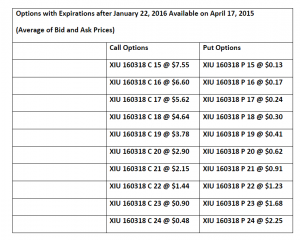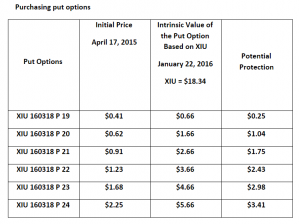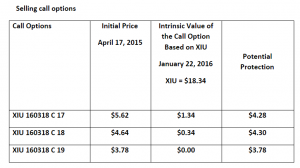Purchasing put options or selling call options to protect oneself? (Part 2)

In the last article, we compared purchasing put options with selling call options. We reached the conclusion that, in the absence of a known target price and timeframe, it is better to use strategies that take advantage of the decaying time value of options, such as selling call options, as protection against a decline in the value of the underlying asset. Now we will compare the two strategies’ performance again over the same period (from April 17, 2015 to January 22, 2016), but instead of using options with monthly expirations, we will select the first expiration after January 22, 2016. We want to see whether or not being able to correctly predict both the amplitude of a price decline and its duration is useful in making the choice between purchasing put options and selling covered call options as a protective strategy.
Background
It is April 17, 2015 and we hold units of XIU that are trading at $22.55. We believe that XIU will begin trending downward and that, furthermore, it could fall 18.7% to reach $18.34 on January 22, 2016. With a specific target price and time period, we will choose the put option with the best protective potential. We will also choose the call option to sell in order to obtain the best protection value, based on the expected price decline. We will then compare the results obtained under these two strategies.



We want to select the put option with the best protection value, based on a target price for XIU of $18.34, among the put options with strikes between $19 and $24. Since we cannot know the precise values of these options on January 22, 2016, we have calculated their intrinsic values. Given this group of put options, the best protection is given by XIU 160318 P 24 at $2.25, which has a potential protection value of $3.41 (the intrinsic value of $5.66 less the purchase price of $2.25).

We want to select the call option with the best protection value, based on a target price for XIU of $18.34. We have compared call options with strikes of $17, $18 and $19 that we could sell for $5.62, $4.64 and $3.78, respectively. We then calculated each option’s intrinsic value, which are $1.34, $0.34 and $0.00, respectively, based on a price of $18.34 for XIU. We then determined that the potential protection value of each of these options will be $4.28, $4.30 and $3.78, respectively. Based on this information, we decided to sell call options XIU 160318 C 18 at $4.64.

On January 22, 2016, we closed our positions at the market price when there was still some time remaining to our options’ expiration on March 18, 2016. Once again, we see that the selling of call options has managed to outperform the strategy of purchasing put options, since it provides $3.82 compared to $3.53, respectively, of protection value. This $0.29 advantage is mainly due to the decay of the options’ time value, which benefits the option seller at the expense of the holder.
Much like in the previous article, this analysis shows that a strategy involving the sale of call options appears to be the better choice. But this time we used a scenario very specifically focused on amplitude and duration, and our level of certainty was close to 100%. However, since such certainty is not found in real life and markets can do just the opposite of what you might expect, you may nevertheless be justified in choosing to purchase put options. One of the features of purchasing put options for protection is that they can allow you to benefit from a price increase should this occur, despite your expectations.
In this instance, we decided to purchase put options with a strike of $24 and, as a result, we were positioned to profit from XIU rising to above $24, should this have happened. Selling call options with a strike of $18 would have ruled out this opportunity. So there are always compromises to be made when choosing between strategies. In our example, this means focusing only on protection or also being able to take some profits if our forecasts fail to materialize. The decision is ours.
Good luck with your trading, and have a good week!
The strategies presented in this blog are for information and training purposes only, and should not be interpreted as recommendations to buy or sell any security. As always, you should ensure that you are comfortable with the proposed scenarios and ready to assume all the risks before implementing an option strategy.
President
Monetis Financial Corporation
Martin Noël earned an MBA in Financial Services from UQÀM in 2003. That same year, he was awarded the Fellow of the Institute of Canadian Bankers and a Silver Medal for his remarkable efforts in the Professional Banking Program. Martin began his career in the derivatives field in 1983 as an options market maker for options, on the floor at the Montréal Exchange and for various brokerage firms. He later worked as an options specialist and then went on to become an independent trader. In 1996, Mr. Noël joined the Montréal Exchange as the options market manager, a role that saw him contributing to the development of the Canadian options market. In 2001, he helped found the Montréal Exchange’s Derivatives Institute, where he acted as an educational advisor. Since 2005, Martin has been an instructor at UQÀM, teaching a graduate course on derivatives. Since May 2009, he has dedicated himself full-time to his position as the president of CORPORATION FINANCIÈRE MONÉTIS, a professional trading and financial communications firm. Martin regularly assists with issues related to options at the Montréal Exchange.
The information provided on this website, including financial and economic data, quotes and any analysis or interpretation thereof, is provided solely for information purposes and shall not be construed in any jurisdiction as providing any advice or recommendation with respect to the purchase or sale of any derivative instrument, underlying security or any other financial instrument or as providing legal, accounting, tax, financial or investment advice. Bourse de Montréal Inc. recommends that you consult your own advisors in accordance with your needs before making decision to take into account your particular investment objectives, financial situation and individual needs.
All references on this website to specifications, rules and obligations concerning a product are subject to the rules, policies and procedures of Bourse de Montréal Inc. and its clearinghouse, the Canadian Derivatives Clearing Corporation, which prevail over the content of this website. Although care has been taken in the preparation of the documents published on this website, Bourse de Montréal Inc. and/or its affiliates do not guarantee the accuracy or completeness of the information published on this website and reserve the right to amend or review, at any time and without prior notice, the content of these documents. Neither Bourse de Montréal Inc. nor any of its affiliates, directors, officers, employees or agents shall be liable for any damages, losses or costs incurred as a result of any errors or omissions on this website or of the use of or reliance upon any information appearing on this website.
BAX®, CADC®, CGB®, CGF®, CGZ®, LGB®, MX®, OBX®, OGB®, OIS-MX®, ONX®, SCF®, SXA®, SXB®, SXF®, SXH®, SXM®, SXO®, SXY®, and USX® are registered trademarks of the Bourse. OBW™, OBY™, OBZ™, SXK™, SXJ™, SXU™, SXV™, Montréal Exchange and the Montréal Exchange logo are trademarks of the Bourse. All other trademarks used are the property of their respective owners.
© 2024 Bourse de Montréal Inc. All Rights Reserved.
